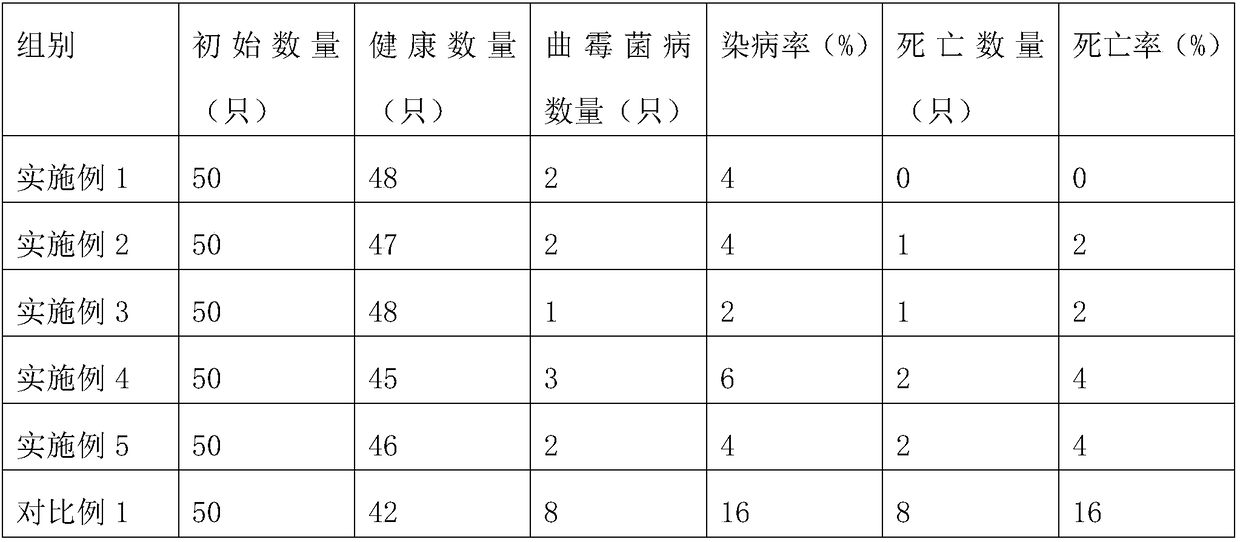Breeding method for preventing and controlling chicken aspergillus
A breeding method, aspergillus technology, applied in the field of poultry farming, can solve problems such as adverse reactions of chicks, and achieve the effect of improving the immunity of chicks and promoting healthy growth
- Summary
- Abstract
- Description
- Claims
- Application Information
AI Technical Summary
Problems solved by technology
Method used
Image
Examples
Embodiment 1
[0025] A breeding method for preventing and treating chicken aspergillosis, comprising the following steps:
[0026] Step 1. Chick selection: select healthy and disease-free chicks;
[0027] Step 2. Brooding room management: Disinfect and discharge the brooding room before the chicks enter the room;
[0028] Step 3, daily management: epidemic prevention is carried out according to conventional breeding; regularly disinfect and discharge the brooding room;
[0029] Step 4, feeding management: a, chick is born 24h, feeds nutrient water to chick, and nutrient water is added water soaking 1~2h after being pulverized by honeysuckle and Radix Radix, then filters and makes (the ratio of the total volume of powder of honeysuckle and Radix Radix to the volume of water For (3-5): 40); b. Chicks are 1-3 weeks old, fed 5-7 times a day, and feed antibacterial feed to chicks every 2.5-3.5h; the raw materials and weight parts included in the antibacterial feed The numbers are: 100 parts of...
Embodiment 2
[0038] The difference between Example 2 and Example 1 is that the antibacterial feed includes raw materials and parts by weight: 80 parts of corn, 90 parts of soybeans, 15 parts of kelp, 10 parts of shiitake mushrooms, 12 parts of Bupleurum, 5 parts of Artemisia annua 3 parts of copper sulfate, 10 parts of zinc-selenium tea, and 0.8 parts of electrolytic multidimensional; the raw materials and parts by weight included in the conventional feed are: 100 parts of corn, 75 parts of soybeans, 15 parts of kelp, 15 parts of shiitake mushrooms, and 10 parts of Bupleuri And Artemisia annua 5 parts.
Embodiment 3
[0039] The difference between Example 3 and Example 1 is that the antibacterial feed includes raw materials and parts by weight: 90 parts of corn, 80 parts of soybeans, 20 parts of kelp, 15 parts of shiitake mushrooms, 10 parts of Bupleuri, 8 parts of Artemisia annua 2.5 parts of copper sulfate, 12 parts of zinc-selenium tea and 0.6 parts of electrolytic multidimensional; the raw materials and parts by weight included in the conventional feed are: 80 parts of corn, 80 parts of soybeans, 16 parts of kelp, 12 parts of shiitake mushrooms, and 9 parts of Bupleurum And Artemisia annua 8 parts.
PUM
 Login to View More
Login to View More Abstract
Description
Claims
Application Information
 Login to View More
Login to View More - R&D
- Intellectual Property
- Life Sciences
- Materials
- Tech Scout
- Unparalleled Data Quality
- Higher Quality Content
- 60% Fewer Hallucinations
Browse by: Latest US Patents, China's latest patents, Technical Efficacy Thesaurus, Application Domain, Technology Topic, Popular Technical Reports.
© 2025 PatSnap. All rights reserved.Legal|Privacy policy|Modern Slavery Act Transparency Statement|Sitemap|About US| Contact US: help@patsnap.com

